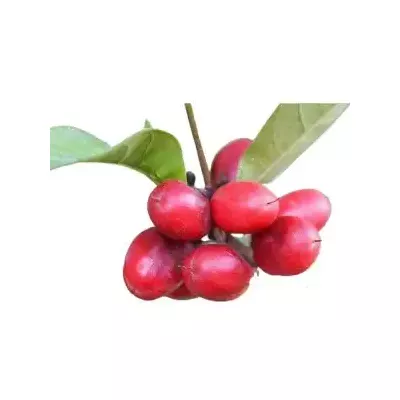



Miracle fruit is an African plant that grows as shrubs of 5–6 feet in height. The name Miracle Fruit comes from the fact that after eating this fruit for up to two hours, whatever food we eat will taste sweet.

Pay using UPI, Card or Netbanking

Shipping within 3 working days
Synsepalum dulcificum, commonly known as miracle fruit, is a tropical shrub or small tree that is native to West Africa. The plant has attractive foliage and produces striking red berries. They belong to the sapodilla family.
The effects of eating miracle fruit can last up to 2 hours, and during that time, sour and acidic foods taste remarkably sweet.
Growth type: Miracle fruit is a slow-growing, evergreen shrub or small tree that can reach a height of 2 to 4 meters.
Suitable climatic and soil conditions: Miracle fruit prefers tropical or subtropical climates and can grow in different soil types, including sandy, loamy, and clay soils. In other words, it can grow in most places in India.
Miracle berry plant prefers a slightly acidic soil.
They are slow-growing and can easily be grown in a container. Seedlings start bearing fruit in the third year, but the layered plants start giving fruit much earlier, usually within a year.
Sunlight needs: Miracle fruit prefers partial shade but can tolerate full sun exposure. They can be grown indoors where bright indirect light is available.
Planting distance: It is recommended to plant Miracle Fruit at a distance of 1.5 to 2 meters apart.
Pruning: Pruning is not necessary for miracle fruit but can be done to control the plant's size and shape.
Water requirements: Miracle fruit prefers regular watering but can tolerate short periods of drought once established.
Ease of maintenance and growing tips: Miracle fruit is relatively easy to grow and maintain. Fertilizing the plant with a balanced fertilizer can help promote healthy growth.
Fruit Description: Fruit Description: Miracle fruit is a small, red berry that is approximately 2 to 3 centimeters in diameter. The miracle fruit has a thin and smooth skin.
Taste: The flesh of the miracle fruit is not sweet on its own but contains a glycoprotein called miraculin, which binds to taste buds and alters their perception of taste. When consumed, sour and acidic foods taste sweet.
The Miracle Fruit helps cancer patients enjoy the unique taste of food if they lose the taste of their tongue after chemo. It is also good for diabetics and those who are dieting.
The fruit is consumed for its ability to alter taste perception, making sour and acidic foods taste sweet. It is often used as a natural sweetener and flavour enhancer.
Medicinal uses: Consuming miracle fruit may help people with diabetes, obesity, and various gastrointestinal disorders.
Nutritional value: Miracle fruit is rich in antioxidants. It is a good source of vitamin C and fiber.
Data sheet